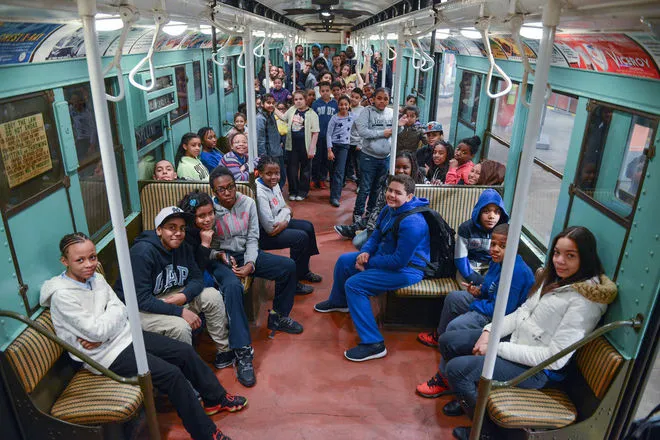The New York Transit Museum, also known as the NYC Subway Museum, is a fascinating institution dedicated to preserving and showcasing the rich history of public transportation in New York City. Here’s an in-depth look at the museum and its various aspects:
- Location: The main museum is housed in a decommissioned subway station at the corner of Boerum Place and Schermerhorn Street in Downtown Brooklyn. Additionally, there is a satellite location at Grand Central Terminal in Manhattan.
- Foundation: Established in 1976, the museum was created to celebrate the 75th anniversary of the New York City Subway system.
- Mission: The museum’s mission is to preserve the history, artifacts, and stories of New York City’s extensive public transit system, which includes subways, buses, and commuter rail services.
Exhibits and Collections
Permanent Exhibits
- History of New York City Transit:
- Chronicles the development of the city’s transit system from the late 19th century to the present day.
- Features maps, photographs, and historical documents detailing the construction and expansion of the subway.
- Vintage Subway Cars:
- A highlight of the museum is its collection of vintage subway cars dating from 1904 to the present.
- Visitors can walk through and explore these meticulously restored cars, experiencing the evolution of subway design and technology.
- Bus Collection:
- Includes vintage buses that have served the city, showcasing the development of bus transit alongside the subway.
- Turnstiles and Fare Collection:
- Displays a variety of turnstiles and fare collection devices used throughout the history of the subway.
- Demonstrates the evolution from ticket booths to modern MetroCard readers and the OMNY contactless fare system.
- Interactive Exhibits:
- Features hands-on exhibits where visitors can simulate driving a bus or operating a subway train.
- Includes interactive displays explaining the mechanics and engineering behind the transit system.
Special Exhibits
- Rotating Exhibits: The museum hosts temporary exhibits focusing on specific themes, such as the impact of public transit on urban development, art in the subway, and the role of women in transit history.
- Art in Transit: Explores the role of public art in the subway system, including mosaics, sculptures, and performances that enhance the transit environment.
Educational Programs
- School Programs: Offers a range of educational programs for school groups, including guided tours and hands-on workshops designed to align with educational standards.
- Public Programs: Hosts lectures, panel discussions, and film screenings on topics related to transit history, urban planning, and transportation policy.
- Family Programs: Includes special activities and events for families, such as storytelling sessions, crafts, and holiday-themed events.
Restoration and Preservation for NYC Subway Museum
- Restoration Projects: The museum is actively involved in the restoration and preservation of historical transit vehicles and artifacts.
- Preservation Efforts: Works to document and preserve the history of the city’s transit system through archival collections, including photographs, blueprints, and historical records.
Accessibility and Visitor Information
- Accessibility: The museum is accessible to visitors with disabilities, with accommodations such as elevators and ramps.
- Visitor Amenities: Features a gift shop with transit-themed merchandise and a café offering refreshments.
- Hours and Admission: Open year-round, with specific hours and admission fees listed on the museum’s official website. Offers discounts for students, seniors, and children.
Community Engagement
- Outreach Programs: Engages with the local community through outreach programs that bring the history and importance of public transit to a wider audience.
- Volunteer Opportunities: Offers opportunities for volunteers to assist with tours, educational programs, and special events.
Importance and Impact
- Cultural Significance: The New York Transit Museum plays a vital role in preserving the history and heritage of the city’s transit system, which is integral to New York’s identity and daily life.
- Educational Value: Provides valuable educational resources for students, historians, and transit enthusiasts, fostering a deeper understanding of urban transportation.
The New York Transit Museum is a unique institution that offers a comprehensive and engaging look at the history and evolution of one of the world’s most iconic public transportation systems. Whether you are a transit enthusiast, a history buff, or simply curious about how New York City’s transit system works, the museum provides a wealth of information and an enriching experience.
Natural History Museum NYC Subway Stop
The American Museum of Natural History (AMNH) in New York City is conveniently located near several subway stations, with the most notable being the 81st Street–Museum of Natural History station. Here are the detailed aspects of the subway stops serving the museum:
81st Street–Museum of Natural History Station
Lines
- B Line: Runs during weekdays only.
- C Line: Runs at all times except late nights.
Station Features
- Location: The station is situated at Central Park West and 81st Street, directly adjacent to the museum.
- Entrances and Exits:
- 81st Street and Central Park West: Main entrance providing direct access to the museum.
- 79th Street and Central Park West: Another entrance a couple of blocks south, serving the southern part of the museum complex.
- Accessibility: The station is equipped with elevators, making it accessible for people with disabilities. There are elevators at both the 81st Street and 79th Street entrances.
Layout
- Mezzanine Level: The station features a large mezzanine with fare control areas. It is decorated with colorful mosaics and murals depicting various natural history themes.
- Platform Level: The station has two side platforms, one for each direction of travel. The walls are adorned with mosaic murals of prehistoric animals and other natural history subjects.
Other Nearby Subway Stations [NYC Subway Museum]
72nd Street Station (B, C Lines)
- Location: 72nd Street and Central Park West.
- Distance: About a 10-minute walk south of the museum.
- Features: This station can serve as an alternative for those traveling on the B and C lines, especially if they miss their stop at 81st Street.
86th Street Station (1 Line)
- Location: Broadway and 86th Street.
- Distance: About a 15-minute walk west of the museum.
- Features: This station on the 1 line provides access from the west side of Manhattan. Walking east from this station through the Upper West Side neighborhood offers a scenic approach to the museum.
Tips for Visitors
- Museum Access: The 81st Street entrance offers the most direct access to the museum’s main entrance.
- Rush Hours: Plan your visit outside of typical rush hours (8-9 AM and 5-6 PM) for a more comfortable trip.
- Weekend Service: Check MTA service updates, as weekend service changes might affect B and C lines, and plan accordingly.
By using the 81st Street–Museum of Natural History station, visitors can enjoy a seamless and convenient journey to one of New York City’s most iconic museums.
![NYC Subway Map [New York Subway Map] ❤️](https://nycsubwaymap.net/wordpress/wp-content/uploads/2023/12/NYC-Subway-Logo.png)

